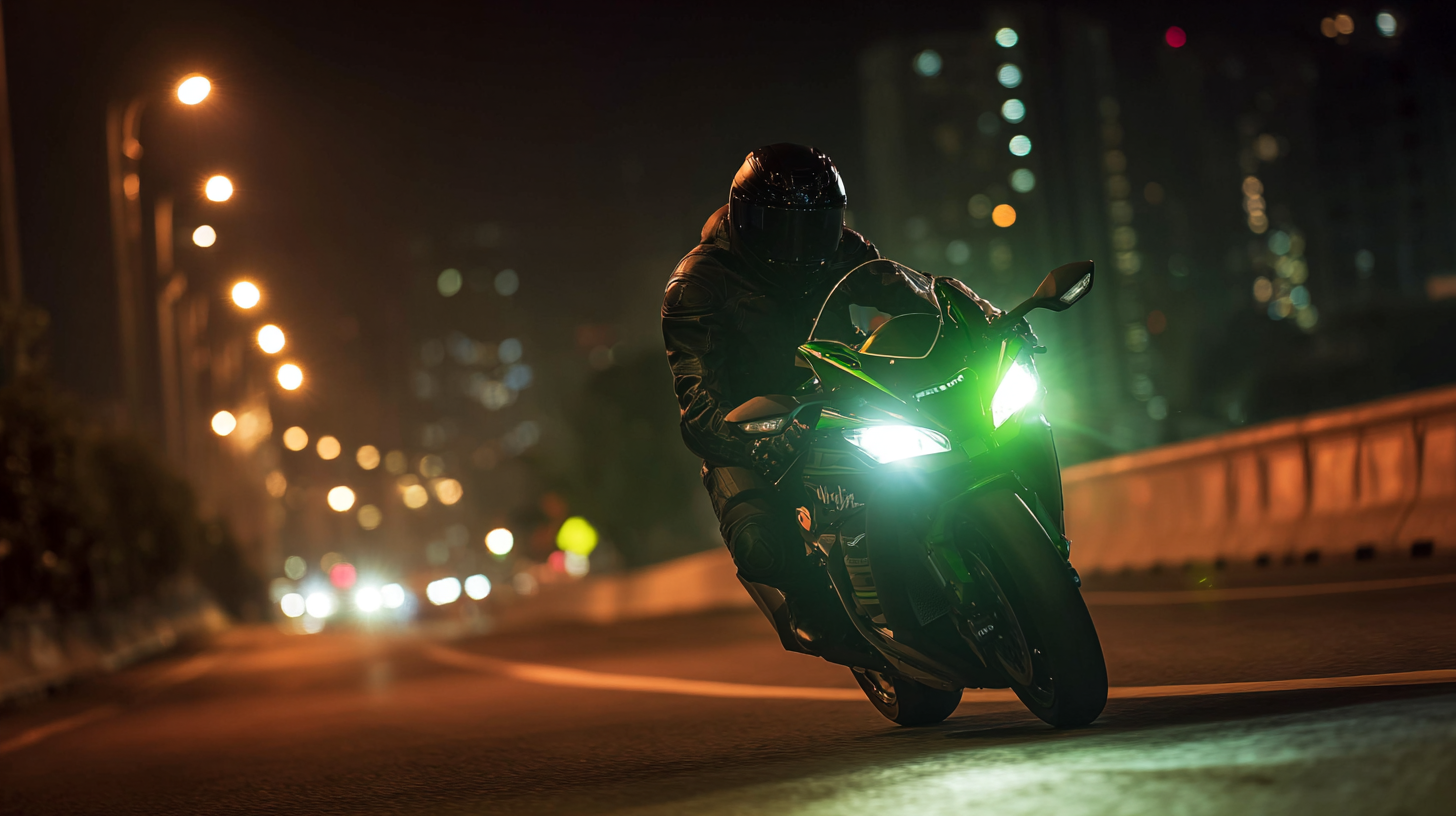Leave Your Message
Night riding on motorcycles can be both exhilarating and dangerous, which is why choosing the right motorcycle light is crucial for ensuring safety on the road. According to the NHTSA, approximately 25% of motorcycle accidents occur at night, highlighting the need for better visibility. The right motorcycle light not only illuminates the path ahead but also makes riders more visible to other drivers, thereby reducing the risk of collisions.

Recent studies indicate that riders who utilize high-quality LED motorcycle lights can enhance their visibility by up to 200% compared to traditional halogen bulbs. LED lights provide a brighter, more focused beam, which is essential for navigating poorly lit roads and avoiding potential hazards. As the motorcycle industry continues to innovate, it becomes increasingly important for riders to stay informed about the latest advancements in motorcycle lighting technology to improve their safety during night rides.
In this guide, we will delve into the top 10 motorcycle lights available in the market today, equipping riders with the knowledge needed to make an informed decision tailored to their specific night riding needs. Whether you are a seasoned rider or a newcomer, understanding the advantages of each type of motorcycle light will empower you to enhance your night riding experience.
When it comes to night riding safety, the importance of motorcycle lighting cannot be overstated. According to the National Highway Traffic Safety Administration (NHTSA), nearly 40% of motorcycle crashes occur at night, despite only 20% of total motorcycle miles being ridden after dark. Proper lighting plays a crucial role in visibility, allowing riders to see obstacles and for other road users to see the motorcycle, significantly reducing the risk of accidents.
Choosing the right motorcycle lights is essential for enhancing safety during nighttime rides. LED lights are highly recommended due to their brightness and energy efficiency; they can increase visibility up to 400% compared to standard halogen bulbs. Moreover, incorporating additional lighting features such as running lights or auxiliary lights can further enhance a motorcycle's visibility. Riders should also consider using light systems with adjustable angles to ensure they illuminate the road effectively, especially on winding paths.
**Tips for Night Riding Safety:**
1. Ensure all headlights and taillights are functioning correctly and clean to maximize visibility.
2. Invest in high-quality reflective gear to increase your chances of being seen in low-light conditions.
3. Practice riding at night in a safe environment to get accustomed to how your motorcycle handles in the dark.
| Lighting Type | Brightness (Lumens) | Beam Distance (Meters) | Battery Life (Hours) | Water Resistance |
|---|---|---|---|---|
| LED Headlight | 2500 | 200 | 12 | IP67 |
| Halogen Light | 1200 | 150 | 8 | IP65 |
| Xenon Light | 3000 | 175 | 10 | IP66 |
| Fog Light | 800 | 60 | 5 | IP54 |
When it comes to motorcycle safety at night, the type of lighting you choose can make a significant difference. The global motorcycle lighting market is projected to grow from $2.34 billion in 2025 to $3.22 billion by 2032, reflecting an increasing recognition of the importance of effective lighting solutions. From headlights to tail lights, various types of motorcycle lights cater to different needs and preferences. For instance, LED lights are becoming increasingly popular due to their brightness and energy efficiency, providing enhanced visibility on the road.
Understanding the different types of motorcycle lights available is crucial for ensuring safety during night rides. Headlights serve as the primary source of illumination, while auxiliary lights offer additional visibility to motorists. Taillights, on the other hand, play a vital role in alerting drivers behind you. The right combination of these lights not only increases your visibility but also enhances the overall riding experience. As the market for motorcycle lights continues to evolve, bikers can explore numerous innovative options that promise to keep them safe and seen, regardless of the biking conditions.
 When selecting motorcycle lights for night riding, there are several key features to consider to ensure optimal visibility and safety. First and foremost, brightness is crucial. Look for lights with a high lumen output, as this will ensure that you can see the road ahead clearly while also making you more visible to other drivers. LEDs are a popular choice because they provide bright illumination while consuming less power compared to traditional halogen bulbs.
When selecting motorcycle lights for night riding, there are several key features to consider to ensure optimal visibility and safety. First and foremost, brightness is crucial. Look for lights with a high lumen output, as this will ensure that you can see the road ahead clearly while also making you more visible to other drivers. LEDs are a popular choice because they provide bright illumination while consuming less power compared to traditional halogen bulbs.
Another important aspect to consider is the beam pattern. A good motorcycle light should have an adjustable beam to allow you to direct the light where it is needed most. This flexibility is essential for dealing with varying terrain and road conditions. Additionally, consider the durability of the lights. They should be built to withstand harsh weather conditions and vibrations while riding. Lights with an IP rating will indicate water resistance, which is vital for night rides in unexpected weather. By focusing on these key features, you can choose the perfect motorcycle lights that enhance your safety while riding at night.
When it comes to motorcycle safety, particularly during night riding, understanding industry standards and regulations is essential. The global motorcycle lighting market is projected to grow significantly, from $2.34 billion in 2025 to an anticipated $3.22 billion by 2032, reflecting a compound annual growth rate (CAGR) of 4.7%. This growth highlights the increasing importance placed on effective lighting solutions that comply with safety standards. Regulations set by authorities ensure that motorcycle lights meet specific luminosity and visibility criteria, fundamentally aimed at reducing road traffic accidents, especially in high-risk regions like the Asia-Pacific.
Moreover, the push for illegal vehicle modifications poses a continual threat to safety standards. Recent findings noted over 26,000 illegal modifications in Korea alone, emphasizing the need for stringent compliance with safety regulations regarding motorcycle lighting. Innovations in lighting technology, including advancements in LED systems, are not only enhancing visibility but are also crucial in adhering to global standards. With organizations like UNECE and ESCAP prioritizing road safety initiatives, it is imperative for manufacturers and riders alike to remain informed and aligned with these evolving regulations.
LED technology has revolutionized the world of motorcycle lighting, providing riders with enhanced visibility and performance during night rides. Unlike traditional incandescent bulbs, LEDs emit a brighter light while consuming less power. This increased brightness helps illuminate the road more effectively, allowing riders to spot obstacles, other vehicles, and potential hazards from greater distances. With advances in LED design, high-intensity options are now readily available, making nighttime riding safer than ever before.
Moreover, the performance benefits of LED lights extend beyond mere brightness. Many modern LED motorcycle lights feature adjustable beams and adaptable modes, enabling riders to tailor their illumination according to riding conditions. This versatility is crucial when navigating varied terrains or poorly lit areas, as it enhances both visibility and awareness. Additionally, the longevity of LED lights means less frequent replacements, which not only saves costs but also contributes to a more reliable ride. Overall, the integration of LED technology into motorcycle lighting systems is a game-changer, significantly elevating safety standards for night riding enthusiasts.







